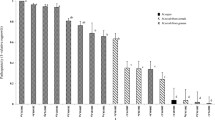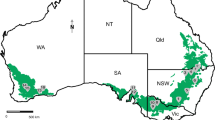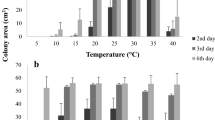Abstract
Twenty-eight Pyricularia isolates from two wild foxtails—green foxtail (Setaria viridis) and giant foxtail (S. faberii)—in Japan were taxonomically characterized by DNA analyses, mating tests, and pathogenicity assays. Although most of the isolates failed to produce perithecia in mating tests with Magnaporthe oryzae, a diagnostic polymerase chain reaction-restriction fragment length polymorphism phenotype of M. oryzae was detected in the beta-tubulin genomic region in all isolates. The pathogenicity assays revealed that host ranges of the isolates were similar to those of isolates from foxtail millet (S. italica), which were exclusively pathogenic on foxtail millet. In addition to the 28 isolates from wild foxtails, 22 Pyricularia isolates from 11 other grasses were analyzed by RFLP using single-copy sequences as probes. In a dendrogram constructed from the RFLP data, isolates that were previously identified as M. oryzae formed a single cluster. All the wild foxtail isolates formed a subcluster with foxtail millet isolates within the M. oryzae cluster. From these results, we conclude that Pyricularia isolates from the wild foxtails are closely related to isolates from foxtail millet and should be classified into the Setaria pathotype of M. oryzae.


Similar content being viewed by others
References
Asuyama H (1963) Morphology, taxonomy, host range, and life cycle of Piricularia oryzae. In: Ou SH (ed) The rice blast disease. Johns Hopkins Press, Baltimore, pp 9–22
Couch BC, Kohn LM (2002) A multilocus gene genealogy concordant with host preference indicates segregation of a new species, Magnaporthe oryzae, from M. grisea. Mycologia 94:683–693
Dekker J (2004) The evolutionary biology of the foxtail (Setaria) species-group. In: Inderjit (ed) Weed biology and management. Kluwer, The Netherlands, pp 65–113
Doust AN, Kellogg EA (2002) Inflorescence diversification in the panicoid “bristle grass” clade (Paniceae, Poaceae): evidence from molecular phylogenies and developmental morphology. Am J Bot 89:1203–1222
Eto Y, Ikeda K, Chuma I, Kataoka T, Kuroda S, Kikuchi N, Don LD, Kusaba M, Nakayashiki H, Tosa Y, Mayama S (2001) Comparative analyses of the distribution of various transposable elements in Pyricularia and their activity during and after the sexual cycle. Mol Gen Genet 264:565–577
Fukunaga K, Domon E, Kawase M (1997) Ribosomal DNA variation in foxtail millet, Setaria italica (L.) P. Beauv., and a survey of variation from Europe and Asia. Theor Appl Genet 95:751–756
Itoi S, Mishima T, Arase S, Nozu M (1983) Mating behavior of Japanese isolates of Pyricularia oryzae. Phytopathology 73:155–158
Kato H (1983) Responses of Italian millet, oat, timothy, Italian ryegrass and perennial ryegrass to Pyricularia species isolated from cereals and grasses (in Japanese). Proc Kanto-Tosan Plant Prot Soc 30:22–23
Kato H, Yamaguchi T (1980) Host ranges and interrelations of Pyricularia species from various cereals and grasses (in Japanese). Proc Kanto-Tosan Plant Prot Soc 27:14–15
Kato H, Yamamoto M, Yamaguchi-Ozaki T, Kadouchi H, Iwamoto Y, Nakayashiki H, Tosa Y, Mayama S, Mori N (2000) Pathogenicity, mating ability and DNA restriction fragment length polymorphisms of Pyricularia populations isolated from Gramineae, Bambusideae and Zingiberaceae plants. J Gen Plant Pathol 66:30–47
Kusaba M, Eto Y, Don LD, Nishimoto N, Tosa Y, Nakayashiki H, Mayama S (1999) Genetic diversity in Pyricularia isolates from various hosts revealed by polymorphisms of nuclear ribosomal DNA and the distribution of the MAGGY retrotransposon. Ann Phytopathol Soc Jpn 65:588–596
Kusaba M, Hasegawa M, Fujita Y, Yaegashi H (2001) Analysis of the genetic components of peridial tissue of perithecia in the blast fungus. J Gen Plant Pathol 67:200–204
Kusaba M, Hirata K, Sumida Y, Yamagashira A, Konagai-Urata H, Yaegashi H (2006) Molecule genetic characterization and host specificity of Pyricularia isolates from annual ryegrass in Japan. Plant Pathol J 5:72–79
Luo CX, Hanamura H, Sezaki H, Kusaba M, Yaegashi H (2002) Relationship between avirulence genes of the same family in rice blast fungus Magnaporthe grisea. J Gen Plant Pathol 68:300–306
Luo CX, Yin LF, Koyanagi S, Farman ML, Kusaba M, Yaegashi H (2005) Genetic mapping and chromosomal assignment of Magnaporthe oryzae avirulence genes AvrPik, AvrPiz, and AvrPiz-t controlling cultivar specificity on rice. Phytopathology 95:640–647
Mayr E (1940) Speciation phenomena in birds. Am Nat 74:249–278
Namai T, Nukina M, Saigusa M, Togashi J (1996) Blast disease occurred on wild rice, Zizania palustris L. caused by Pyricularia sp (in Japanese with English abstract). Ann Phytopathol Soc Jpn 62:247–253
Nei M, Li WH (1979) Mathematical model for studying genetic variation in terms of restriction endonucleases. Proc Natl Acad Sci USA 76:5269–5273
Nishikado Y (1917) Studies on the rice blast fungus, (I). Ber Ohara Inst Landwirtsch Forsch 1:171–218
Rohlf FJ (1998) NTSYS-pc., version 2.0. Numerical taxonomy and multivariate analysis system. Exeter Publishing, New York
Rossman AY, Howard RJ, Valent B (1990) Pyricularia grisea, the correct name for the rice blast disease fungus. Mycologia 82:509–512
Skinner DZ, Budde AD, Farman ML, Smith JR, Leung H, Leong SA (1993) Genome organization of Magnaporthe grisea: genetic map, electrophoretic karyotype, and occurrence of repeated DNAs. Theor Appl Genet 87:545–557
Tosa Y, Hirata K, Tamba H, Nakagawa S, Chuma I, Isobe C, Osue J, Urashima AS, Don LD, Kusaba M, Nakayashiki H, Tanaka A, Tani T, Mori N, Mayama S (2004) Genetic constitution and pathogenicity of Lolium isolates of Magnaporthe oryzae in comparison with host species-specific pathotypes of the blast fungus. Phytopathology 94:454–462
Yaegashi H (1981) Studies on the perfect stage of Pyricularia species (in Japanese). Bull Tohoku Natl Agric Exp Stn 63:49–125
Acknowledgments
We are grateful to Dr. M. Kawase, Genebank, National Institute of Agrobiological Sciences (NIAS), for providing the seeds of the foxtail millet landraces and Dr. M. L. Farman, Department of Plant Pathology, Kentucky University, for providing the plasmid clones used as probes for the scRFLP analysis. Special thanks are due to Dr. H. Yaegashi, former professor at Saga University, for providing valuable suggestions.
Author information
Authors and Affiliations
Corresponding author
Rights and permissions
About this article
Cite this article
Yamagashira, A., Iwai, C., Misaka, M. et al. Taxonomic characterization of Pyricularia isolates from green foxtail and giant foxtail, wild foxtails in Japan. J Gen Plant Pathol 74, 230–241 (2008). https://doi.org/10.1007/s10327-008-0087-3
Received:
Accepted:
Published:
Issue Date:
DOI: https://doi.org/10.1007/s10327-008-0087-3




